Abstract
A central role in anal carcinogenesis of high-risk types of human papillomaviruses (hrHPV) was recently established, but the possible role of benign anal lesions has not been addressed in hrHPV-positive and -negative anal cancers. As part of a population-based case-control study in Denmark and Sweden, we interviewed 417 case patients (93 men and 324 women) diagnosed during the period 1991-94 with invasive or in situ anal cancer, 534 patients with adenocarcinoma of the rectum and 554 population controls. Anal cancer specimens (n = 388) were tested for HPV by the polymerase chain reaction. Excluding the 5 years immediately before diagnosis, men, but not women, with anal cancer reported a history of haemorrhoids [multivariate odds ratio (OR) 1.8; 95% confidence interval (CI) 1.04-3.2] and unspecific anal irritation (OR 4.5; CI 2.3-8.7) significantly more often than controls. Women with anal cancer did not report a history of benign anal lesions other than anal abscess to any greater extent than controls, but they had used anal suppositories more often (OR 1.5; CI 1.1-2.0). Patients with hrHPV in anal cancer tissue (84%) and those without (16%) reported similar histories of most benign anal lesions, but anal fissure or fistula was more common among hrHPV-positive cases. Ulcerative colitis and Crohn's disease, reported by <1% of study participants, were not associated with anal cancer risk. The higher proportion of hrHPV-positive anal cancers among case patients with anal fissure or fistula suggests that such mucosal lesions may provide direct viral access to basal epithelial layers. Since risk associations with benign anal lesions in men may be confounded by unreported sexual behaviour, and since risk associations in women were generally negative, it seems unlikely that benign anal lesions act as promoters in hrHPV-associated anal carcinogenesis. Moreover, benign anal lesions appear not to be linked to an alternative, hrHPV-unassociated causal pathway to anal cancer. Ulcerative colitis and Crohn's disease were not supported as causal factors for anal cancer.
Full text
PDF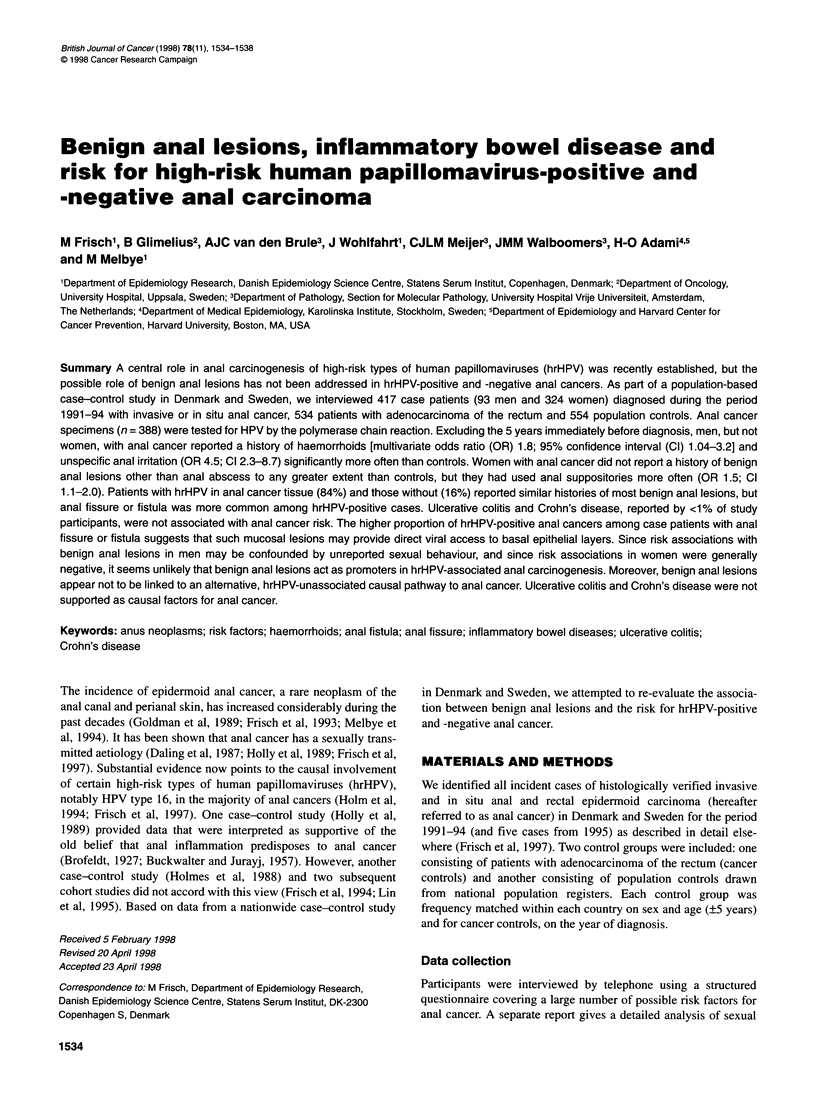
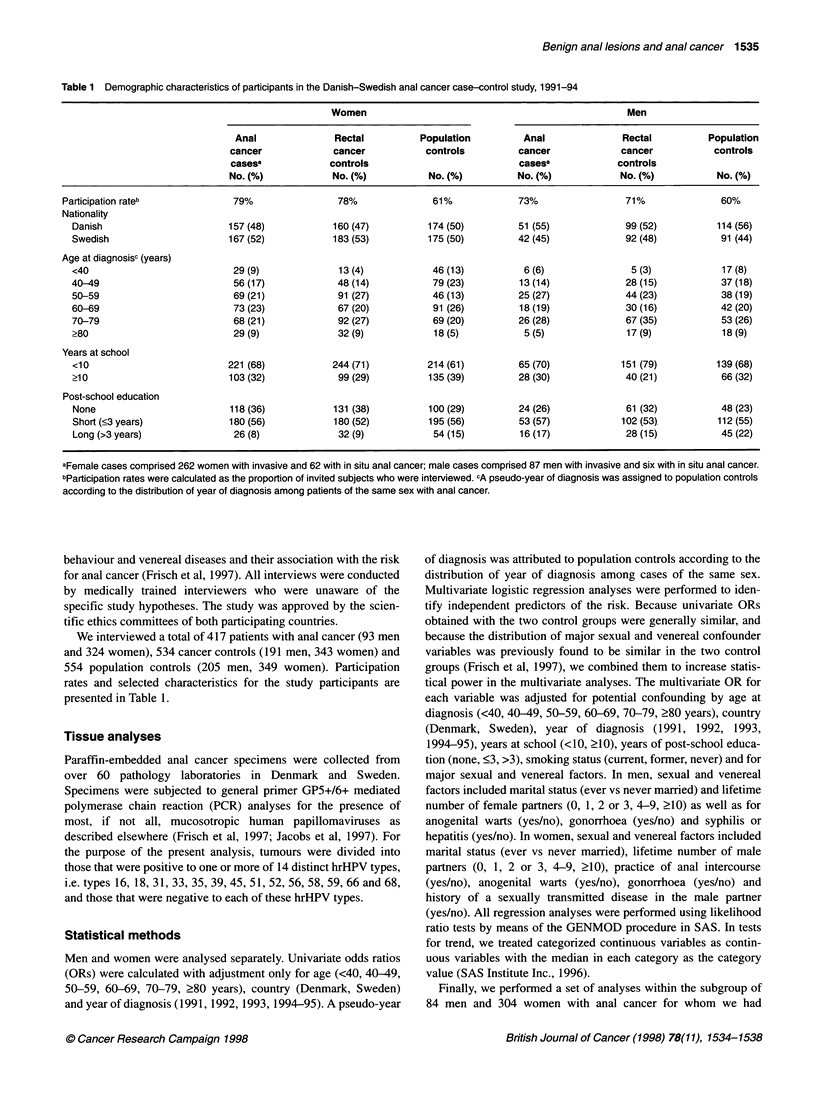
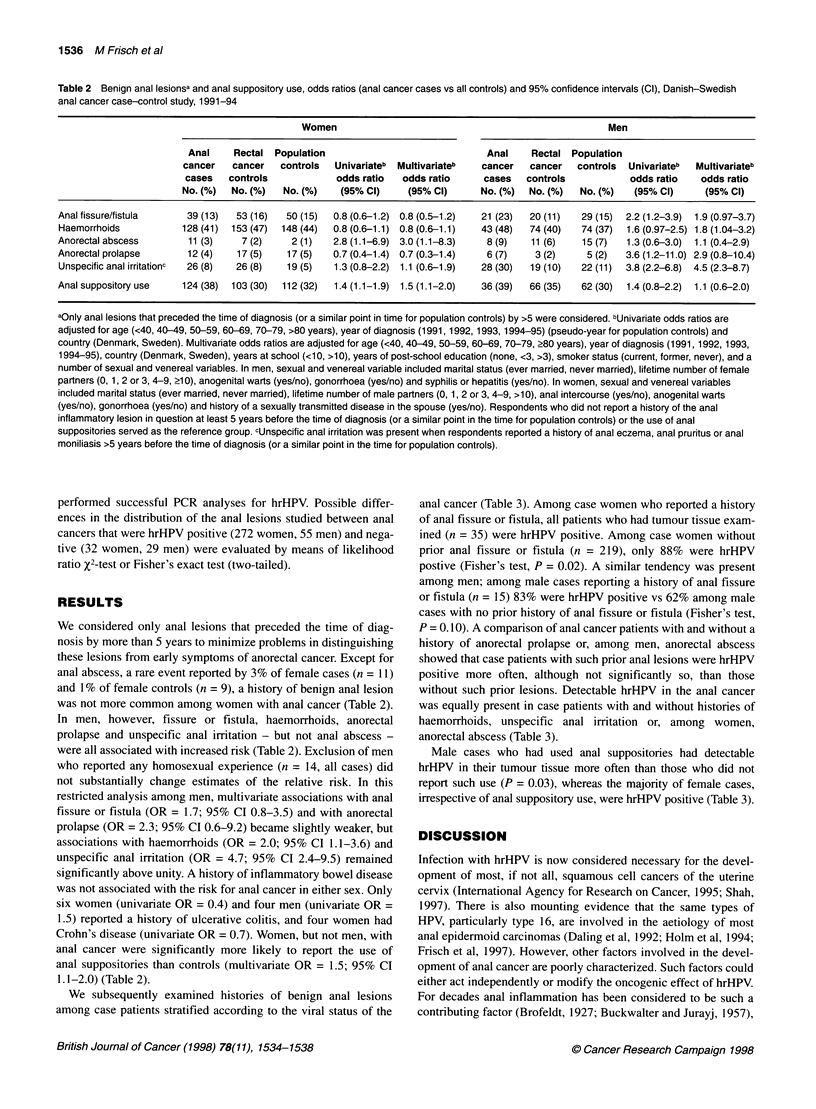
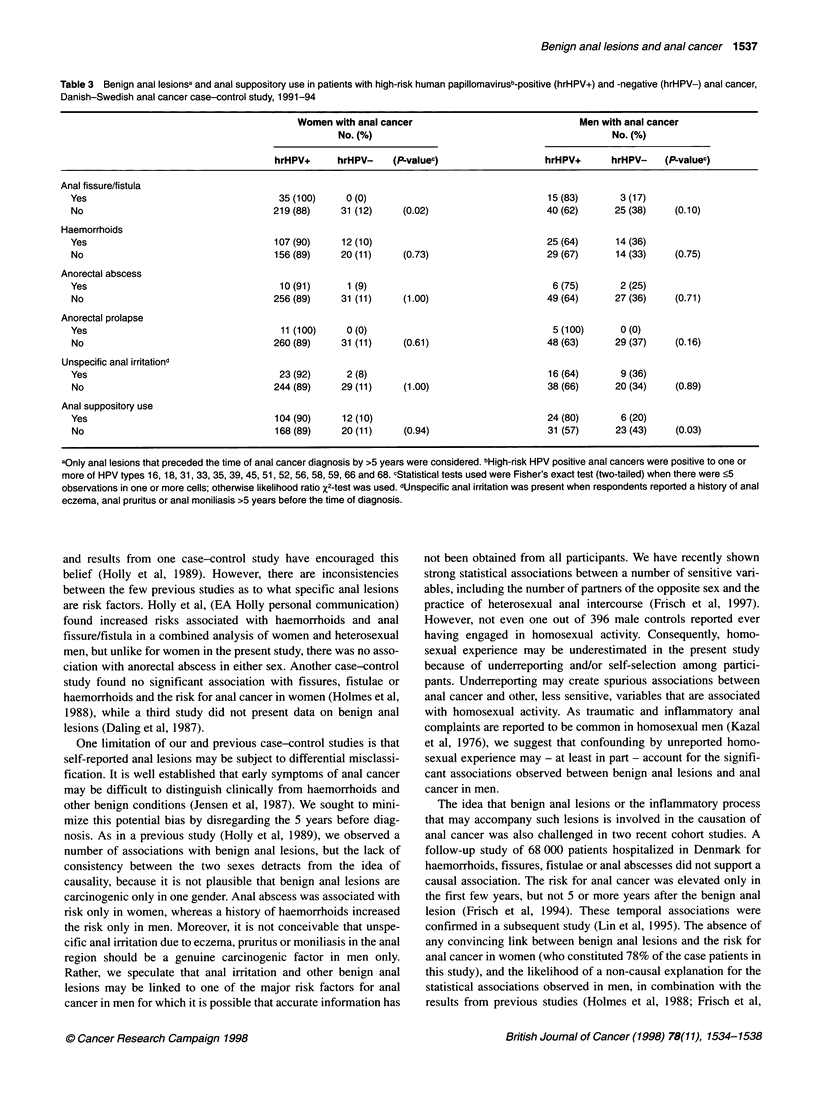
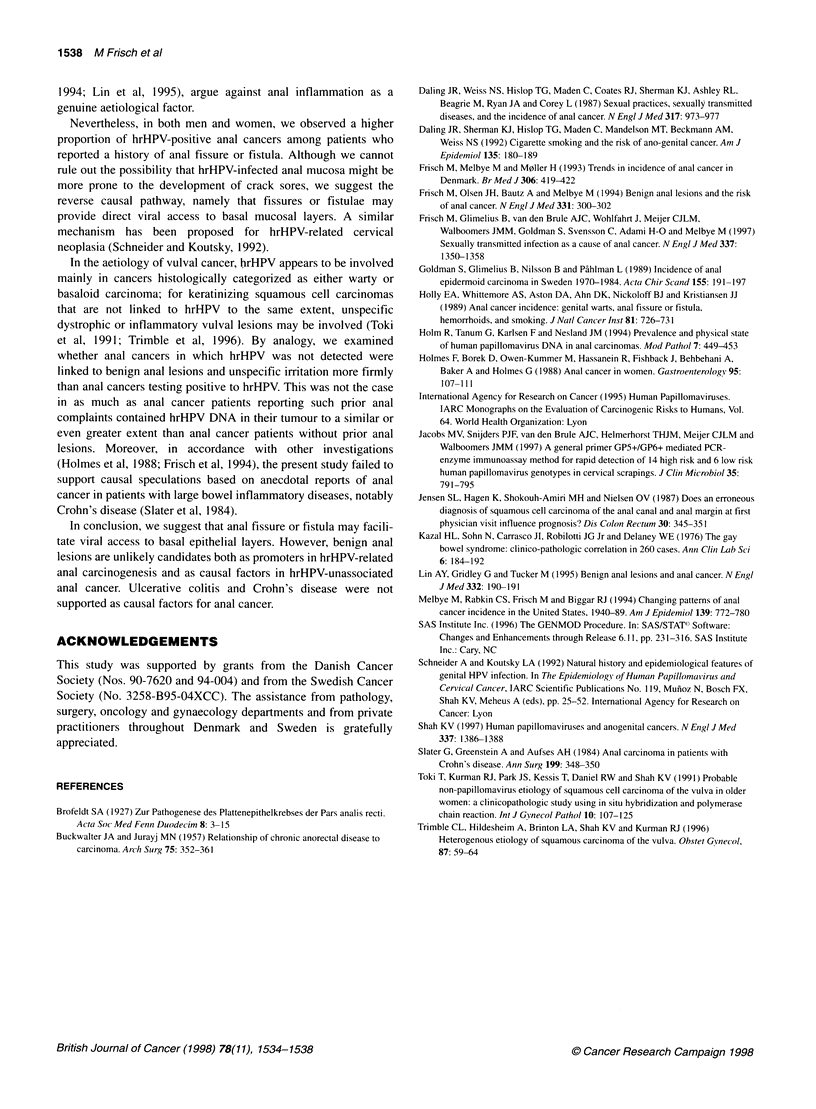
Selected References
These references are in PubMed. This may not be the complete list of references from this article.
- BUCKWALTER J. A., JURAYJ M. N. Relationship of chronic anorectal disease to carcinoma. AMA Arch Surg. 1957 Sep;75(3):352–361. doi: 10.1001/archsurg.1957.01280150042005. [DOI] [PubMed] [Google Scholar]
- Daling J. R., Sherman K. J., Hislop T. G., Maden C., Mandelson M. T., Beckmann A. M., Weiss N. S. Cigarette smoking and the risk of anogenital cancer. Am J Epidemiol. 1992 Jan 15;135(2):180–189. doi: 10.1093/oxfordjournals.aje.a116270. [DOI] [PubMed] [Google Scholar]
- Daling J. R., Weiss N. S., Hislop T. G., Maden C., Coates R. J., Sherman K. J., Ashley R. L., Beagrie M., Ryan J. A., Corey L. Sexual practices, sexually transmitted diseases, and the incidence of anal cancer. N Engl J Med. 1987 Oct 15;317(16):973–977. doi: 10.1056/NEJM198710153171601. [DOI] [PubMed] [Google Scholar]
- Frisch M., Glimelius B., van den Brule A. J., Wohlfahrt J., Meijer C. J., Walboomers J. M., Goldman S., Svensson C., Adami H. O., Melbye M. Sexually transmitted infection as a cause of anal cancer. N Engl J Med. 1997 Nov 6;337(19):1350–1358. doi: 10.1056/NEJM199711063371904. [DOI] [PubMed] [Google Scholar]
- Frisch M., Melbye M., Møller H. Trends in incidence of anal cancer in Denmark. BMJ. 1993 Feb 13;306(6875):419–422. doi: 10.1136/bmj.306.6875.419. [DOI] [PMC free article] [PubMed] [Google Scholar]
- Frisch M., Olsen J. H., Bautz A., Melbye M. Benign anal lesions and the risk of anal cancer. N Engl J Med. 1994 Aug 4;331(5):300–302. doi: 10.1056/NEJM199408043310504. [DOI] [PubMed] [Google Scholar]
- Goldman S., Glimelius B., Nilsson B., Påhlman L. Incidence of anal epidermoid carcinoma in Sweden 1970-1984. Acta Chir Scand. 1989 Mar;155(3):191–197. [PubMed] [Google Scholar]
- Holm R., Tanum G., Karlsen F., Nesland J. M. Prevalence and physical state of human papillomavirus DNA in anal carcinomas. Mod Pathol. 1994 May;7(4):449–453. [PubMed] [Google Scholar]
- Holmes F., Borek D., Owen-Kummer M., Hassanein R., Fishback J., Behbehani A., Baker A., Holmes G. Anal cancer in women. Gastroenterology. 1988 Jul;95(1):107–111. doi: 10.1016/0016-5085(88)90297-1. [DOI] [PubMed] [Google Scholar]
- Jacobs M. V., Snijders P. J., van den Brule A. J., Helmerhorst T. J., Meijer C. J., Walboomers J. M. A general primer GP5+/GP6(+)-mediated PCR-enzyme immunoassay method for rapid detection of 14 high-risk and 6 low-risk human papillomavirus genotypes in cervical scrapings. J Clin Microbiol. 1997 Mar;35(3):791–795. doi: 10.1128/jcm.35.3.791-795.1997. [DOI] [PMC free article] [PubMed] [Google Scholar]
- Jensen S. L., Hagen K., Shokouh-Amiri M. H., Nielsen O. V. Does an erroneous diagnosis of squamous-cell carcinoma of the anal canal and anal margin at first physician visit influence prognosis? Dis Colon Rectum. 1987 May;30(5):345–351. doi: 10.1007/BF02555452. [DOI] [PubMed] [Google Scholar]
- Kazal H. L., Sohn N., Carrasco J. I., Robilotti J. G., Delaney W. E. The gay bowel syndrome: clinico-pathologic correlation in 260 cases. Ann Clin Lab Sci. 1976 Mar-Apr;6(2):184–192. [PubMed] [Google Scholar]
- Lin A. Y., Gridley G., Tucker M. Benign anal lesions and anal cancer. N Engl J Med. 1995 Jan 19;332(3):190–191. doi: 10.1056/nejm199501193320315. [DOI] [PubMed] [Google Scholar]
- Mahaney F. X., Jr Fighting cancer with cigarette taxes. J Natl Cancer Inst. 1989 May 10;81(10):726–728. doi: 10.1093/jnci/81.10.726. [DOI] [PubMed] [Google Scholar]
- Melbye M., Rabkin C., Frisch M., Biggar R. J. Changing patterns of anal cancer incidence in the United States, 1940-1989. Am J Epidemiol. 1994 Apr 15;139(8):772–780. doi: 10.1093/oxfordjournals.aje.a117073. [DOI] [PubMed] [Google Scholar]
- Shah K. V. Human papillomaviruses and anogenital cancers. N Engl J Med. 1997 Nov 6;337(19):1386–1388. doi: 10.1056/NEJM199711063371911. [DOI] [PubMed] [Google Scholar]
- Slater G., Greenstein A., Aufses A. H., Jr Anal carcinoma in patients with Crohn's disease. Ann Surg. 1984 Mar;199(3):348–350. doi: 10.1097/00000658-198403000-00016. [DOI] [PMC free article] [PubMed] [Google Scholar]
- Toki T., Kurman R. J., Park J. S., Kessis T., Daniel R. W., Shah K. V. Probable nonpapillomavirus etiology of squamous cell carcinoma of the vulva in older women: a clinicopathologic study using in situ hybridization and polymerase chain reaction. Int J Gynecol Pathol. 1991;10(2):107–125. doi: 10.1097/00004347-199104000-00001. [DOI] [PubMed] [Google Scholar]
- Trimble C. L., Hildesheim A., Brinton L. A., Shah K. V., Kurman R. J. Heterogeneous etiology of squamous carcinoma of the vulva. Obstet Gynecol. 1996 Jan;87(1):59–64. doi: 10.1016/0029-7844(95)00351-7. [DOI] [PubMed] [Google Scholar]


